I’ve received astute observations in some of my correspondence: why do I (deliberately?) ignore PA labelling on reviews of “Made in India” sunscreens.
That’s an oxymoron if ever there was one.
The short answer is India (as at 18/01/2020) has ZERO specific sunscreen standards /rules/laws/regulations that manufacturers have to follow.
While, manufacturers should be truthful in the claims they make on sunscreens, they have a freehand on how they define what PA+ or PA+++ is. No-one is checking the veracity of such claims.
Nonsensical PA labelling…
Lotus Herbals, one of the biggest sunscreen brands in India, has over 34 Sun Care products.
All sunscreens ranging from SPF 30, SPF 40, SPF 50 as well as SPF 70 claim to have the same PA+++ rating.

Source: Lotus Herbal sunscreensIn these blogs, I have checked the labels of the SPF 30, SPF 40, SPF 50, SPF 100+ products and with the increase in SPF, there is also an increase in Avobenzone in the formulation. This makes it impossible for all of these products to offer the same level of UVA protection being PA+++ and I am willing to bet my entire shoe collection on that.
I have a lot of shoes.
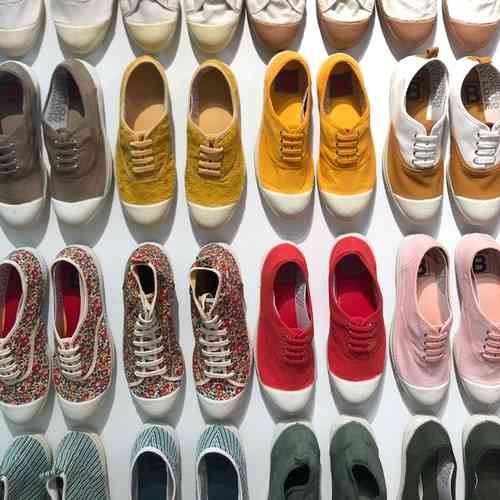
PA labelling 101
Today’s blog is about PA labelling 101…Look away now if your more interested in the Nancy Pelosi’s 32 impeachment signing pens, because this is your official nerd alert…

1) Back to UVA basics
As you are aware, sunscreen is designed to protect from the damaging effects of over-exposure to Ultra Violet Radiation (UVR) (See what damage is sunscreen trying to prevent? for more info)
UVR comprises of UVC (ignore), UVB and UVA. UVB (280-320nm) is the shorter and higher energy radiation and about 5% reaches us.
UVA (320-400nm) is less energetic, but about 95% of UVR reaching us is UVA. UVA is made of UVA2 and UVA1.
Most of UVR is UVA1.
BOTH UVA and UVB have been implicated in skin cancer, photoaging, immuno-suppression and cataracts. But I find this table useful to emphasise that UVA is mainly responsible for photoaging:

Source: Happyskindays, copyrighted asserted.2) Basis of UVA measurement: UVB has SPF…what about UVA?
A sunscreen’s protection against UVB is given by the SPF number, which is based on measuring Erythema (or reddening of the skin).
With UVA its all about Pigmentation:
- Pigmentation that immediately occurs after exposure and fades away immediately is referred to as IPD
- PPD (or Persistent Pigmentation Darkening) is the skin darkening that persists 2 hours to 24 hours after the end of UVA exposure
- Lastly there is Delayed tanning
Note that both IPD and PPD are caused from the oxidation and redistribution of pre-existing melanin. Delayed tanning occurs several days after UVA exposure and relates to the synthesis of new melanin
3) All hail UVAPF
In 1995, the Japanese Cosmetic Industry Association (JCIA), developed a UVA protection factor (UVA-PF) using only Persistent Pigment Darkening (PPD) as the biological endpoint. This original PPD method was like the SPF test, but only used UVA radiation for the exposure source and the minimal dose for PPD as the biological endpoint was what was being measured.
PA labelling system
The results of UVAPF allowed sunscreen manufacturers to display the following labels on their products:
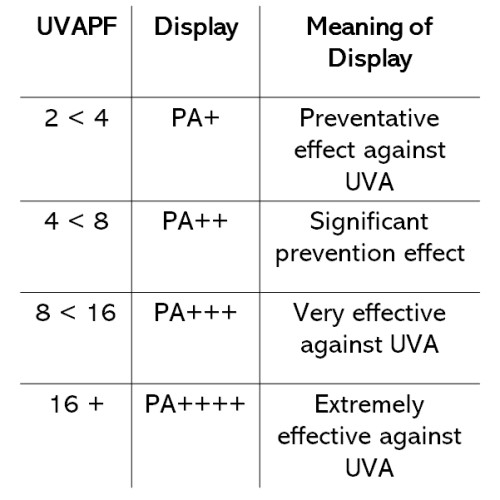
Source: JCIADespite revisions, this table is pretty much the same today.
4) Where are we now?
There are (confusingly) two ISO* (the International Organization for Standardization)s which cover UVAPF measurement.
*An ISO is basically an international standard which countries then adopt into their own local country law, usually with modifications).
The two ISOs are:
- ISO 24442 (2011) In vivo determination of sunscreen UVA protection
- ISO 24443 (2012) Determination of sunscreen UVA photoprotection in vitro
4.1) Is there even a difference?
In vivo* UVAPF follows the JCIA guidelines and determines UVAPF using human subjects. In vitro* UVAPF follows COLIPA (European body) guidelines and (essentially) uses a plate in a lab as the subject. Ok, I am being flippant with the explanation, as in theory, both in vitro and in vivo should produce the same UVAPF.
But in practice both methods produce different UVAPFs.
* In vivo refers to a medical test, experiment or procedure that is done on (or in) a living organism, such as a laboratory animal or human. In vitro, in contrast to in vivo, refers to a medical study or experiment which is done in the laboratory within the confines of a test tube or laboratory dish.
And here is a study to demonstrate this…
A 2010 study measured both the In vivo UVAPF (the JCIA outline) and In vitro UVAPF (COLIPA guidelines) on a bunch of SPF 30+ sunscreens bought in New Zealand and Australia.
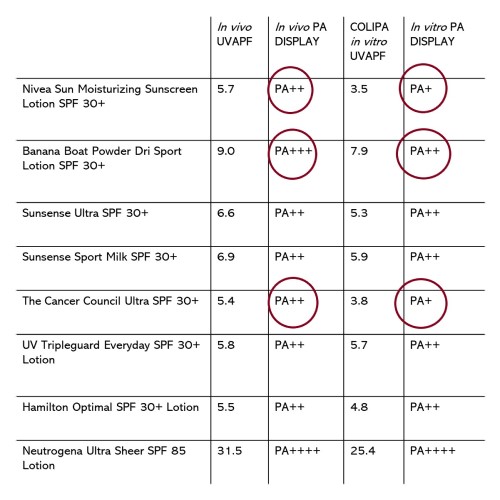
There was a clear difference for most sunscreens. For example, Nivea Sun Moisturising Sunscreen SPF 30+ has a PA+ and a PA++ rating.
(Naturally there are many other more recent studies you can look up)
4.2) Why is this less than ideal?

- It becomes impossible to really compare products in countries (such as India) because we don’t know if manufacturers are using in vivo UVAPF or in vitro UVAPF. This is entirely possible because India has no PA labelling guidelines, but products are full of PA labelling.
- While the SPF number is always indicated for UVB, its not obligatory to publish the UVAPF number. How are you supposed to “guess” the UVAPF no??
- The consumers expectation is if this an SPF PA++ product it will give significant UVA protection – this is not being met. If I keep in mind that studies show individuals use LESS sunscreen then the recommended amount and this exponentially effects the amount of UV protection, then overall consumers are getting less UVA protection than they think you should be getting. This is never a good outcome.
- Other commentators have argued that PA ++++ labelling is too narrow. There is no way to know if the UVAPF is 16 or 40 or 60. That’s a potatoes, patataes (?) distinction for me.
What does this mean in India?
As India has NO PA labelling system dictated by law, manufactures such as Lotus Herbals, Banana Boat, Forest Essentials and so on calculates UVAPF as they see fit.
How do you know a PA+++ rating on brand VYZ sunscreen is really directly comparable to a PA+++ rating on another sunscreen.
You don’t
5) What you should do instead?
- Ignore PA labelling for Made in India sunscreens. (P.S. if you can read Japanese and use Japanese sunscreen, then please don’t ignore PA labelling).
- Read the ingredient label looking for UVA filters. (Read this blog on WHY you need to read ingredient labels to establish the credibility of UVA filters.
- The PHOTOSTABILITY of a product is crucially important, especially as Avobenzone by far, is the most common UVA filter thats used in American and Indian sunscreens.
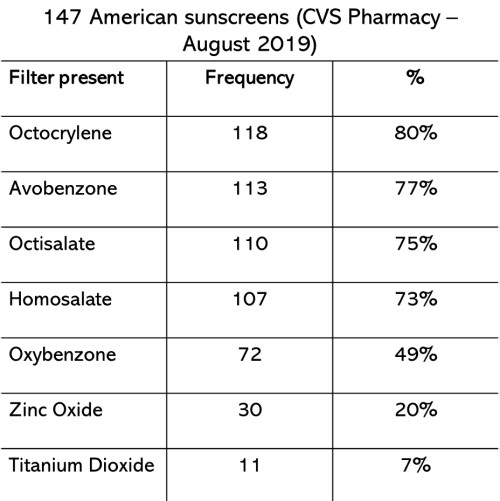
Source: own research, copyright asserted.- Outside the US, especially in the EU and India NEW style UVA filters are available:
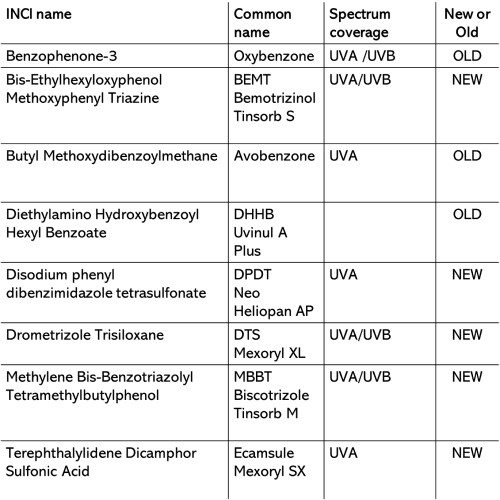
Source: UV-A Protection and Sunscreens Technical Report (2010), Commission International De L'Eclairage The benefit of new UVA filters…
- Provide superior UVA protection
- Are physically heavy molecules, which makes dermal absorption astronomically difficult: all the problems Oxybenzone has are no longer relevant.
- The UVA filters are PHOTOSTABLE, which means fewer other photostabilisers or SPF boosters appear in your product.
- Many of the filters are very effective at low concentrations. Even 1% of BEMT is good news.
The absorbance profile of UVA filters show high absorbance in the UVA 1 (340-400 nm) region…
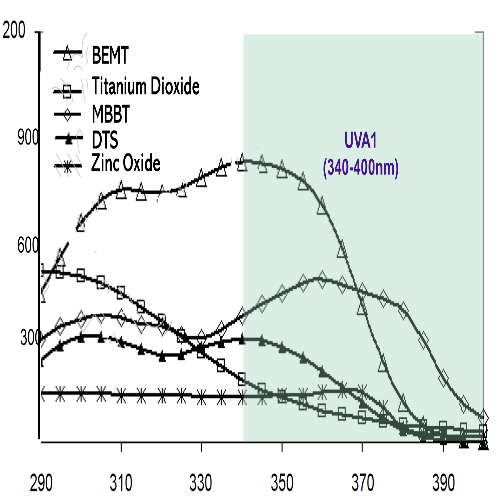
Source: Principles of Photoprotection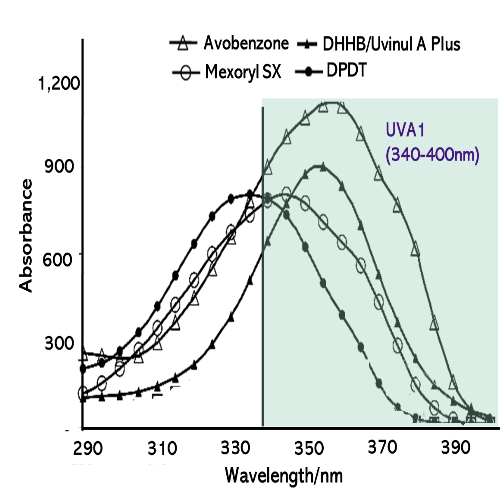
Source: Principles of Photoprotection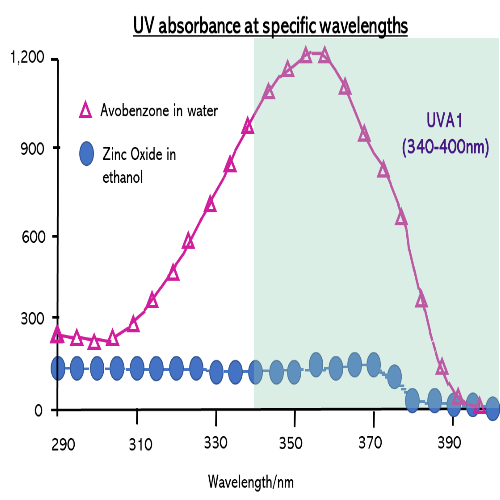
Source: Principles of PhotoprotectionClosing remarks
The difference between PA+ or PA++++ is absolutely redundant if you are not using sunscreen EVERY DAY OF THE YEAR and you are not using sufficient quantities.
I would love to hear what your experience with PA has been. Drop me a line at email@happyskindays.com or leave a comment!
Sources
Mizuno M, Recent Trends in Measurement Methods of UV Protection Effect Journal of Japan Cosmetic Engineers (2013) Volume 47 Issue 4 p. 271-277
Young A et al, Ultraviolet radiation and the skin: Photobiology and sunscreen photoprotection, Journal of the American Academy of Dermatology, (2017) Volume 76, Issue 3, Supplement 1, p.S100-S109
Ou-Yang H et al, An evaluation of ultraviolet A protection and photo-stability of sunscreens marketed in Australia and New Zealand, Photodermatology, Photoimmunology & Photomedicine (2010) 26, 336–337
netti N et al, The New Sunscreens among Formulation Strategy, Stability Issues, Changing Norms, Safety and Efficacy Evaluations, Cosmetics (2017), 4(2), 15 https://doi.org/10.3390/cosmetics4020015
Task Force Committee for Evaluation of Sunscreen Function, Guidelines for New Efficacy Claims of Sunscreen Products, Journal of Japanese Cosmetic Science Society Vol 31, No 4 Supplement, pp 439-447
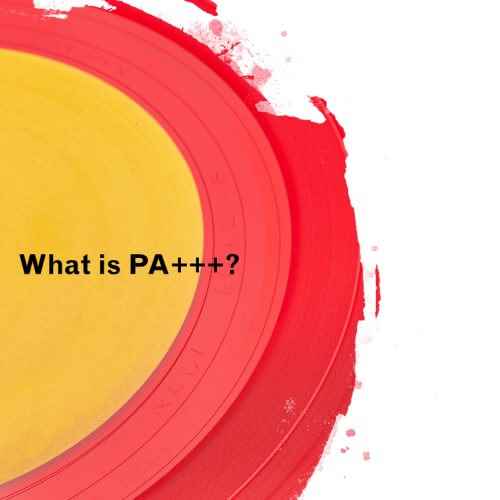
1 thought on “What is PA++++?”
Hey ,,
I love yur content thank you so much